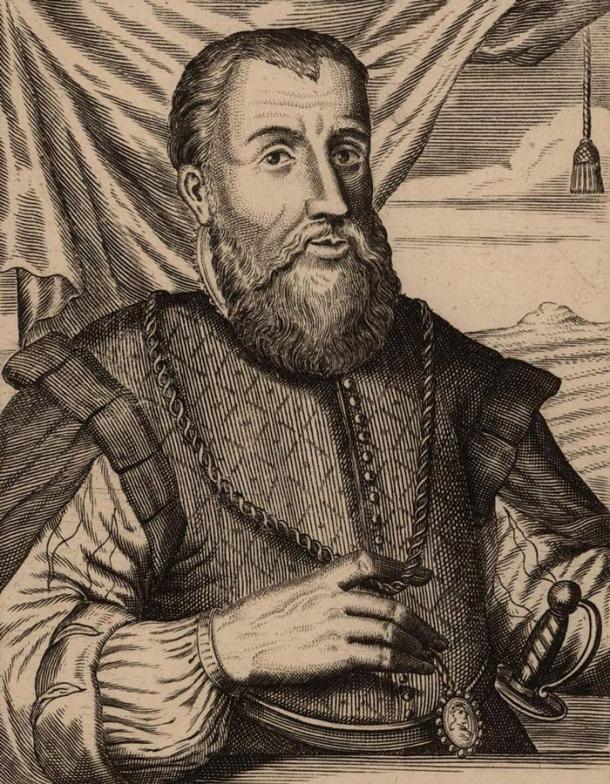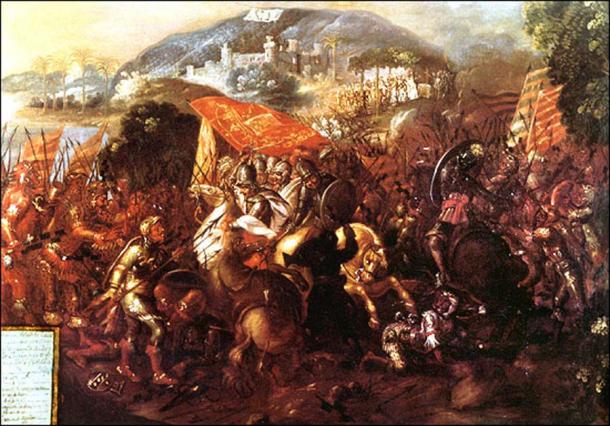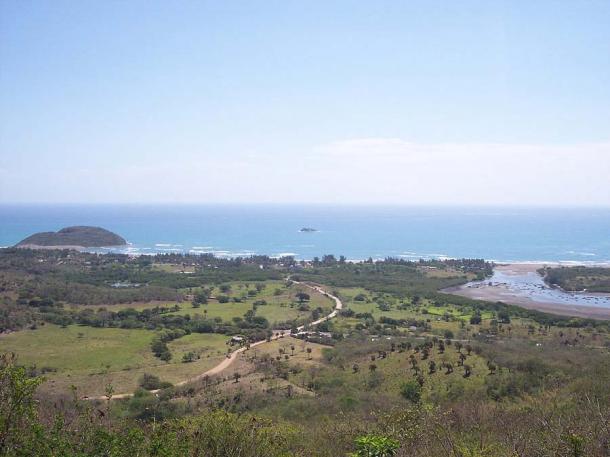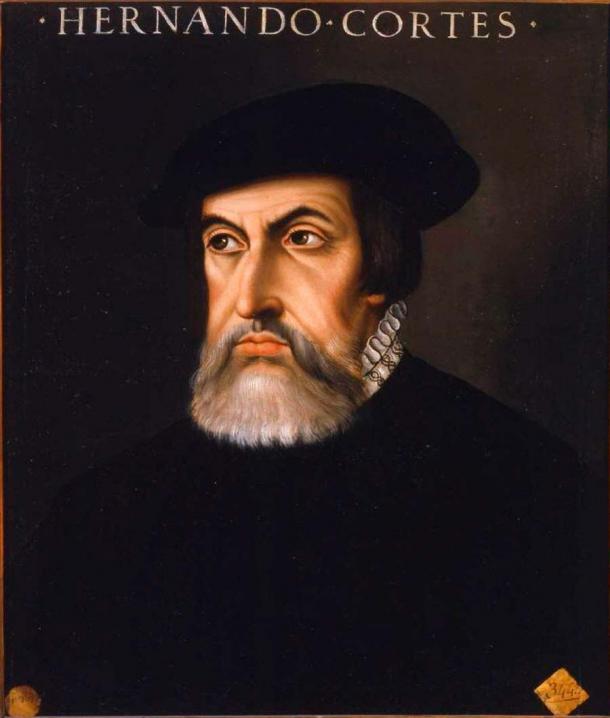Hernan Cortes: The Conquistador Who Beat the Aztecs
Hernan Cortes was a Spanish conquistador who lived between the 15th and 16th centuries AD. He is best remembered for his expedition against the Aztec Empire centered in Mexico. This was part of the first phase of Spain’s expansion into the New World. Hernan Cortes’ expedition resulted in the collapse of the Aztec Empire, and the control of a large part of modern-day Mexico by the Spanish Empire. On the one hand, Cortes is regarded as a heroic character who contributed greatly to the Spanish Empire. On the other hand, he is perceived as a villain whose murderous actions caused the downfall of a sophisticated civilization.
The Early Life of Hernan Cortes
Hernan Cortes was born in 1485 in Medellin, a village in the province of Badajoz, Extremadura, Spain. At that time, Cortes’ place of birth was part of the Kingdom of Castile. Cortes’ father was Martin Cortes de Monroy, an infantry captain, whilst his mother was Catalina Pizarro Altamirano. Cortes’ family belonged to the lesser nobility, though they were by no means wealthy. Incidentally, through his mother, Cortes was a second cousin of Francisco Pizarro, another conquistador who gained fame from his expedition in the New World.
- Becerrillo: The Terrifying War Dog of the Spanish Conquistadors
- Conquistadors caused Toxic Air Pollution 500 years ago by changing Incan Mining
At the age of 14, Cortes was sent to study at the University of Salamanca. This was Spain’s foremost center of learning at the time. Although it is unclear what Cortes studied at the university, it is assumed that he studied Law, and perhaps Latin. It seems that Cortes’ parents were hoping that their son would embark on a legal career, which would have made him wealthy. Unfortunately, Cortes returned to Medellin after spending two years at Salamanca, as studying was probably not his strong point. Although Cortes did not finish his studies, his time at Salamanca did help him familiarize himself with the legal codes of Castile, which would come in handy later in his life.

Hernan Cortes portrait on a Spanish 1000 peseta note from 1992. (vkilikov / Adobe Stock)
Cortes’ return to Medellin was not exactly a change for the better for the future conquistador. As Medellin was only a small village, it would have been a rather stifling place for the ambitious young man. Around the same time, Christopher Columbus was making his voyages to the New World, and news of his exciting discoveries would have certainly reached the ears of Cortes and his parents, who recognized that Cortes might be able to make a name for himself in these newly discovered lands.
Therefore, in 1502, arrangements were made for Hernan Cortes to sail to the New World with Nicolas de Ovando, the newly appointed governor of Hispaniola, and a family acquaintance.
Cortes, however, was not destined to be part of this voyage. Before he could even set sail, Cortes sustained an injury whilst escaping from the bedroom of a married woman in Medellin. Consequently, he had to take some time to recover from his injury, after which, he spent a while wandering around Spain.
Cortes did manage to sail to the New World in 1503, as part of a convoy of merchant ships headed to the capital of Hispaniola, Santo Domingo. Cortes was on a ship commanded by Alonso Quintero, who attempted to deceive his superiors. Quintero did so to reach the New World first, and to secure personal advantages. It is suggested that Quintero’s actions might have been a model for Cortes’ own treacherous behavior when he became a conquistador later on.
In any case, this was still many years before Cortes became the man who conquered the Aztec Empire. When he arrived in Santo Domingo, Cortes registered himself as a citizen, which gave him the right to a building plot, and some land for cultivation. As de Ovando was still the governor at that time, he gave Cortes a repartimiento (corvée labor) of natives and made him a notary of the town of Azuza. Thus, over the next couple of years, Cortes slowly established himself in Hispaniola.

Portrait of Diego Velasquez de Cuellar, who led the expedition to Cuba in which Hernan Cortes was given a chance to prove his spirit. (John Carter Brown Library / Public domain)
Hernan Cortes’ Expedition to Cuba
In 1511, Cortes joined the expedition to conquer Cuba. The expedition was led by Diego Velazquez de Cuellar, an aide to the governor of Hispaniola. Velazquez, who became the governor of Cuba, was so impressed by Cortes that he gave him a high position in the colonial administration.
Although Cortes and Velazquez were initially on good terms, the relationship between the two men deteriorated over time. For instance, Cortes was jailed twice by the governor, but succeeded is escaping on both occasions. Nevertheless, Cortes earned a reputation for being daring and bold. Moreover, following Cortes’ marriage to Catalina Xuarez, Velazquez’s sister-in-law, relations between the two men improved.
In 1518, Velazquez and Cortes signed an agreement, which placed the latter in command of an expedition to explore the coast of Mexico. Cortes was to initiate trade with the indigenous people he met during his voyage. It has been suggested that the governor wanted Cortes to only engage in trade, so that he could have the privilege to conquer the indigenous people himself later.
Cortes, however, used the legal knowledge he gained during his days at Salamanca to insert a clause in the agreement that would allow him to take necessary emergency measures without Velazquez’s prior approval if they profited Spain.
Although Velazquez had earlier commissioned another expedition to explore the Mexican coast, Hernan Cortes’ was much bigger. This earlier one, led by the governor’s nephew, consisted of four ships, whereas Cortes assembled a fleet of 11 ships. About half of Cortes’ expedition was financed by Velazquez. Cortes himself went into debt as a result of borrowing additional funds for the expedition, when his own assets went dry. The financial commitment of both men showed that they were both keenly aware that the conquest of Mexico would bring them great fame, fortune, and glory.
It was also this awareness that made Velazquez suspicious that Cortes would betray him, conquer Mexico on his own, and establish himself as governor of the newly conquered land. Therefore, the governor decided to replace Cortes with someone he had more faith in.
Luis de Medina was sent with Velazquez’s orders to replace Cortes. Unfortunately for de Medina, he was intercepted, and killed by Cortes’ brother-in-law. When Cortes heard the news, he sped up the preparations for his expedition. On the 18 th of February 1519, Cortes was about to set sail, when Velazquez himself arrived at the dock, in one last attempt to revoke the conquistador’s commission. Cortes, however, ignored the governor, and hurriedly sailed off.

This old painting by an unknown artist shows the entrance of Hernan Cortes into the city of Tabasco on the Yucatan. (Public domain)
Before Attacking the Aztecs, Cortes Visits the Yucatan
Prior to arriving on the mainland, Cortes spent some time on the island of Cozumel, where he heard stories of other white men living in the Yucatan. It turns out that there were two Spaniards, Geronimo de Aguilar, and Gonzalo Guerrero living amongst the Maya. These two were survivors of a shipwreck in 1511.
Whilst Guerrero chose to continue living with the Maya, de Aguilar, who was a Franciscan priest, joined Cortes’ expedition. During his time with the Maya, de Aguilar picked up Yucatec Mayan, as well as a few other Mesoamerican languages, which made him valuable as a translator.
Geronimo de Aguilar, however, was not the only translator on Cortes’ expedition. Shortly after leaving Cozumel, the expedition landed at Potonchanon, on the tip of the Yucatan Peninsula. It was here that Cortes found his second translator, a woman whom Cortes referred to as Dona Marina, and known also as Malintzen, or La Malinche.
The story of Malintzen’s early life is unclear, though it is generally accepted that she was born into a family but was enslaved as a child. It is believed that during her slavery, Malintzen was sold several times, which brought her to different parts of the Yucatan Peninsula. As a result of her forced travels, Malintzen became fluent in both Yucatec and Nahuatl, the latter being the language of the Aztecs, and a lingua franca of the area.
When Cortes arrived in Potonchanon, he was given 20 enslaved women, one of whom was Malintzen, as a peace offering. The women were forced to join the expedition and were baptized as Catholics. Malintzen’s linguistic skills were soon recognized, and she was paired with de Aguilar. Initially, Cortes would speak to de Aguilar in Spanish, who would translate it into Yucatec. Malintzen would then translate this into Nahuatl, thereby enabling Cortes to speak with the natives.
Eventually, Malintzen learned Spanish as well, which allowed her to communicate directly between Cortes and the Aztecs he met without de Aguilar as an intermediary. Malintzen, however, was more than just an interpreter, and played a significant role in Cortes’ conquest of the Aztec Empire. For instance, Malintzen was instrumental in helping Cortes to form alliances with tribes that were eager to overthrow their Aztec overlords. Malintzen also uncovered plots against the Spanish, who foiled them before any serious harm could be done. Thus, Malintzen was addressed by Cortes’ men with the title Dona, meaning “Lady.”

It was on this Veracruz, Mexico beach (where the Quiahuiztlan archeological site stands today) that Hernan Cortes landed his Mexican expedition in 1519 and scuttled his fleet to ensure maximum motivation for his soldiers. (Gengiskanhg / CC BY-SA 3.0)
Hernan Cortes Attacks the Aztecs from Veracruz, Mexico
After a few months in the Yucatan, Cortes continued his journey westward, and founded the settlement of La Villa Rica de la Vera Cruz (modern-day Veracruz). Cortes got himself elected as captain-general of the new settlement, which freed him from the authority of Velazquez. It was from this settlement that Cortes began his campaign to conquer the Aztec Empire. Initially, the Aztecs did not see the Spanish as a threat. In fact, their ruler, Moctezuma II sent emissaries to present gifts to these foreign strangers. This, however, did little to change the minds of the Spanish. As a matter of fact, Cortes had all but one of his ships scuttled, which meant that he and his men would either conquer the Aztecs Empire or die trying.
As Cortes marched towards Tenochtitlan, the Aztec capital, he made alliances with the local tribes, one of the first being the Tlaxcalans, who were bitter enemies of the Aztecs. Following the Massacre of Cholula in 1519, more tribes decided to submit to the Spanish, fearing that they would suffer the same fate as the Cholulans if they refused.
In any event, when Cortes and his men arrived in Tenochtitlan, he was warmly welcomed by Moctezuma. It seems that the emperor intended to learn more about the Spanish, especially their weaknesses, so that he could crush them later. Cortes, however, found out about Moctezuma’s plot, and took the emperor hostage, believing that this would stop the Aztecs from attacking him and his men.
In the meantime, an expedition under Panfilo de Narvaez was sent in 1520 by Velazquez to relieve Cortes of his command, capture the renegade conquistador, and bring him back to Cuba to be tried. When he heard of the expedition, Cortes took some of his men, and launched a surprise night attack on de Narvaez’s much larger army, thereby defeating it.
After this victory, he hurried back to Tenochtitlan, as the situation there was quite tense as well. During Cortes’ absence, the Spanish in the city had killed many Aztec nobles during a religious festival, which led to them being besieged in Moctezuma’s palace. When Cortes returned, he decided that the best course of action was to retreat from Tenochtitlan.
The decision to retreat was in part caused by the death of Moctezuma. According to one version of the story, Moctezuma was killed by the Spanish after they realized he had outlived his usefulness. According to another account, the emperor was pelted with stones when he tried to speak to his subjects from a balcony and died of his wounds.
Whilst the Cortes were crossing the causeway to the mainland, his rear guard was attacked by the Aztecs, and he lost many men. This episode became known as La Noche Triste, or “The Night of Sorrows.”

Spanish conquistador, Hernan Cortes, as he must have looked towards the end of his life by an unknown artist. (Real Academia de Bellas Artes de San Fernando / Public domain)
Cortes Takes The Aztec Capital And Moves On
In spite of this victory, the Aztecs had not crushed the Spanish, and Cortes, having regrouped his men, returned to Tenochtitlan in 1521, besieged the city, and captured it. Although the fall of Tenochtitlan made Cortes the conqueror of the Aztec Empire, in reality the Spanish took many more years to conquer the rest of Mesoamerica.
- The Many Burials of Hernan Cortes: Locating the Gravesite of a Conquistador
- Will The Lost Fleet of Hernán Cortés And Its Treasures of the Aztec Finally be Found?
In any case, Cortes’ achievement, as well as all the treasures he brought back to Spain, made him a very popular man when he returned home. At the same time, there were also those who were jealous of Cortes’ success, and sought to bring him down. In 1528, Cortes returned to Spain to seek justice from the Spanish king, Charles V. He succeeded in convincing the king and was rewarded for his efforts in Mexico.
Cortes returned to Mexico in 1530 with new titles, but his powers were reduced. Cortes stayed in Mexico till 1541, and led several expeditions, though these are much less celebrated than his conquest of the Aztec Empire.
In 1541, Cortes returned to Spain, and was part of the expedition against Algiers. In 1547, Cortes decided to return to Mexico, but died whilst he was in Seville on the 2 nd of December that year.
His remains were moved several times, before their location was lost, only to be rediscovered in Mexico City during the 20 th century.
Top image: Hernan Cortes burning his ships to motivate his men as they begin to tackle the Aztec Empire from their base in Veracruz, Mexico. Source: joserpizarro / Adobe Stock
By Wu Mingren
References
American Historical Association, 2021. Jeronimo de Aguilar. [Online]
Available at: https://www.historians.org/teaching-and-learning/teaching-resources-for-...
History.com Editors, 2019. Hernan Cortes. [Online]
Available at: https://www.history.com/topics/exploration/hernan-cortes
Innes, R. H., 2021. Hernán Cortés. [Online]
Available at: https://www.britannica.com/biography/Hernan-Cortes
New World Encyclopedia, 2017. Hernán Cortés. [Online]
Available at: https://www.newworldencyclopedia.org/entry/Hern%C3%A1n_Cort%C3%A9s
Szalay, J., 2018. Hernán Cortés: Conqueror of the Aztecs. [Online]
Available at: https://www.livescience.com/39238-hernan-cortes-conqueror-of-the-aztecs....
The BBC, 2014. Hernando Cortés (1485-1547). [Online]
Available at: http://www.bbc.co.uk/history/historic_figures/cortes_hernan.shtml
The Editors of Encyclopaedia Britannica, 2021. Montezuma II. [Online]
Available at: https://www.britannica.com/biography/Montezuma-II
Women & the American Story, 2021. Life Story: Malitzen (La Malinche). [Online]
Available at: https://wams.nyhistory.org/early-encounters/spanish-colonies/malitzen/



















